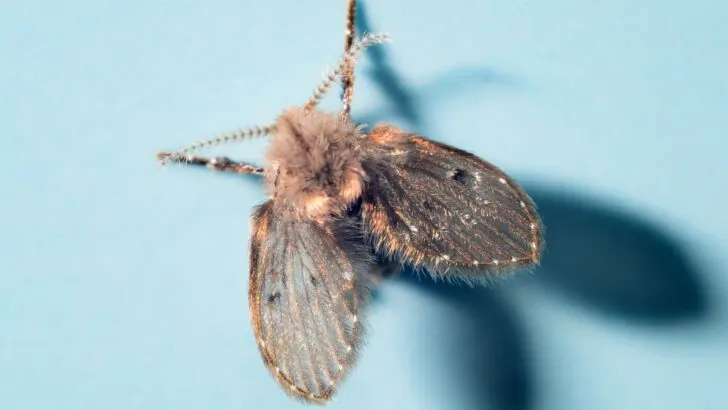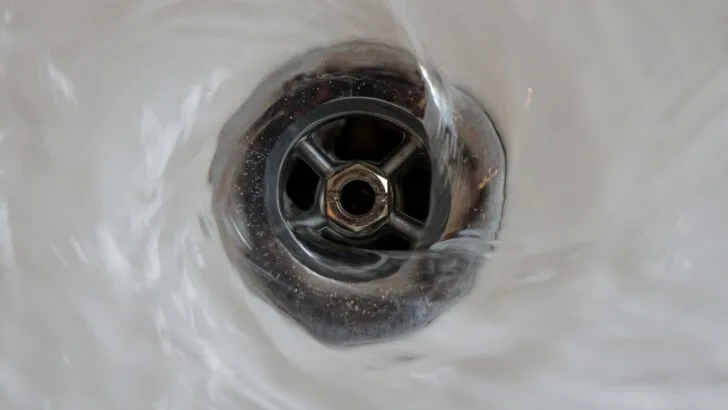If you know anything about pests, you’ll also want to know how to get rid of drain flies in an RV immediately upon discovering them. The day you learn that you’ve got an issue with drain flies is the day to get rid of them before things get out of hand.
Today’s post shares information on how to get rid of drain flies in an RV and keep them from coming back.
What Are Drain Flies?
Drain flies are small black insects that breed in moist organic matter, such as decaying food or sewage. They prefer damp habitats and live in drains, sewers, septic systems, and shallow water.
Technically referred to as Psychodidae, they’re also known as sink flies, or sewer flies, among other names. They can infest your RV’s drains, sinks, showers, and toilets, and can not only become a troubling nuisance in your RV but could potentially create a health hazard.
Contrary to some confusion, drain flies are not fruit flies. You can tell the difference between drain flies and fruit flies because drain/sewer flies look more like small moths, while fruit flies have reddish heads and transparent wings.
Adult drain flies are about 1/6 of an inch long and are generally black, gray, or brown. Their fuzzy wings are wider than their bodies, so they may appear heart-shaped when resting.

Adult drain flies (also known as sewer flies) are fuzzy and have large wings and long antennae.
What Causes Sewer Flies/Drain Flies In an RV?
The most common cause of sewer flies/drain flies is the build-up of organic matter like rotting fruit, food waste, and other organic materials in drain pipes, which provide a breeding ground for them.
Boondocking/dry camping and running only small amounts of water down the drain(s) can exacerbate the problem due to an increased build-up of organic matter. This can make drain flies more likely to emerge.
Another potential source of sewer flies/drain flies is keeping a waste tank dump valve open when connected to a sewer hookup. (We’re talking about the gray valve since no RVer would ever make the critical error of leaving the black valve open… right?)
How to Get Rid of Drain Flies In an RV
Fortunately, there are a number of ways to get rid of sewer flies in an RV. There are also a number of ways to keep them from returning.
Tape Test: Identify the Source
When learning how to get rid of drain flies in an RV, the first step is to identify the source of the problem. If you see drain flies in your RV, you need to figure out where they’re coming from.
They generally lay their eggs in the slime layer that forms on the walls of pipes and drains, and the larvae feed on the organic matter in the drain pipes. In about two weeks’ time, they’ll emerge as adults.
Adult drain/sewer flies are attracted to moisture and light, and they typically congregate in the vicinity of their breeding site or an entry point.
You can use the “tape test” to determine which drain pipe is infested. To do this, simply cover a drain opening with clear tape, leaving a very small gap for airflow. After 24 hours, check the tape to see if any flies are stuck to it.
Repeat this process on each drain in the RV. Wherever you find drain flies on the tape you’ve placed, you’ve identified an area where you have a problem.
Clean and Sanitize Your RV Pipes & Drains
Once you know where the problem is, you’ll want to clean and sanitize the affected drains and pipes to remove any slime layer and kill the eggs & larvae. There are several ways to do this.
Boiling Water
One thing most people have on hand in an RV is water, so this is a popular first step. Simply boil some water on your stove and pour it down the drain. You may need to repeat the process several times over a week or two. The purpose is to dissolve/melt any slime in the pipes and flush out the flies and larvae that the boiling water will kill.

Pouring boiling water down the drain is a start but may need to be followed by other, more effective methods.
The main problem with this method is that it’s often not enough to completely eliminate the flies and larvae, so you may have to repeat the process and/or follow up with additional methods…
Vinegar & Baking Soda
If you’ve got vinegar and baking soda on hand, you have the ingredients for a good follow-up method to boiling water. Vinegar & baking soda combine to create a reaction that helps loosen slime on pipes while also killing more eggs & larvae. A half cup of each is a good place to start, using more if one treatment isn’t enough.
Pour a half cup of baking soda down the drain. Then pour half a cup of white vinegar down the drain and close the drain stopper. Let it sit for about 15-30 minutes, then flush the drain thoroughly with hot water.
Bleach
If you keep bleach on hand to sanitize your RV water system, you can pour some pre-diluted bleach into a sink or shower to treat the gray tank, or into the toilet to treat your RV black water tank. Bleach can kill bacteria and insects, including drain flies. You can treat both tanks at the same time.
Start by dumping your black and gray tanks as usual, then close both drain valves. Flush your toilet (or add water through a hose or by using the black tank flush system) until you’ve filled the black tank to around 3/4 full of water.
Then fill a 1-gallon pitcher or pail mostly full with fresh water and add bleach, figuring 1/4 cup of bleach per 15 gallons of water based on your tank’s capacity.
For example, we have a 45-gallon black tank. So 3/4 cup (1/4 cupp x 3) of bleach diluted into our pitcher of water, then poured down the toilet into the nearly-full black tank is the correct amount of bleach. You can then do the same calculation for the gray tank and pour the bleach/water mix down the shower or sink drain, then rinse it down with plain water.
Avoid pouring pure bleach into the toilet or drains. Always dilute it first to avoid damaging plumbing or toilet seals. Let the bleach & water mixture sit in the tank for 15-20 minutes, and then dump the tank and rinse until you no longer smell bleach.
Drain Cleaners
Foaming drain cleaners can work to remove slimy buildup from pipes. Just be cautious of leaving them lingering too long in your tanks since the chemicals could damage valve seals over time. Always use commercial drain cleaners according to directions.
Enzymatic Cleaners
Enzymatic cleaners use natural enzymes to break down organic matter in your RV tanks. They can be used in your black and gray water tanks, and are safe for pipes, seals, and gaskets. (They’re also non-toxic to humans, animals, and plants.)
To address the issue of drain flies, you can pour enzymatic tank treatments like these down the drain, let them sit for a few hours or even overnight, and then drain and rinse with hot water.
- Powerful Odor Control: Say goodbye to unpleasant odors with our powerful formula that neutralizes and eliminates foul smells, leaving your RV smelling...
- Effective Waste Digestion: Happy Campers breaks down waste and toilet paper quickly and efficiently, preventing clogs and ensuring smooth tank...
- Faster and more effective waste and RV tissue digester. RV Digest-It+ RV black tank treatment breaks down waste and all brands of toilet paper,...
- Our strongest complete RV tank treatment, significantly stronger than RV Digest-It Classic. Breaks down clog-causing waste and eliminates porta potty...
Drain Gels
Drain gels contain insecticides that kill drain flies on contact while also forming a coating on the walls of the pipes. This prevents new flies from laying eggs — an important part of drain fly treatment.
There are a number of drain gel products on the market. The one below is organic and works by dissolving the slime and organic build-up. Its thick consistency also coats pipes and drains for an ounce of prevention. It contains citrus oil, so it has a nice citrus scent.
- Microbes and Citrus Oil
- This product is to be used specifically for drains but can also be used to eliminate sugar snakes in soda fountain drip trays. It is also safe and...
Kill the Adult Flies
Although they have a lifespan of between 8-24 days, drain flies can lay and hatch up to 300 eggs in just 48 hours. So getting rid of the adult flies without getting rid of the larvae won’t solve the problem.
However, killing the adult flies is also an important part of the process. So, once you’ve cleaned, sanitized, and treated your RV’s drains & pipes to eliminate the breeding ground, you must also eliminate the adult flies.
Vinegar Trap
To do this, you can add some apple cider vinegar and liquid dishwashing detergent to a bowl, creating a DIY “fly trap” which you’ll cover with plastic wrap. Poke some holes in the plastic wrap and set the bowl near the affected drain(s). The apple cider vinegar attracts the flies and essentially “traps” them.
Commercial Fly Traps
You can also use traditional commercial fly traps to trap and kill the flies.
- Easy Fly Control – This disposable outdoor hanging fly trap gets rid of common flies, including hundreds of the most prevalent species. Once the...
- Fast Acting — This trap uses an attractant bait that flies can’t resist. Lured by the scent, flies enter the trap through the cap and drown in the...
How to Prevent Drain Fly Infestations
To prevent drain fly infestations in your RV, take the following steps:
- Keep your RV’s drains and pipes clean and dry by regularly flushing them with hot water. Adding baking soda and vinegar is also helpful.
- Periodically clean and sanitize your RV’s black tank and gray tanks with an enzyme drain cleaner or bleach.
- When connected to a sewer hookup, keep your dump valves closed. This blocks a path that drain flies can use to enter your RV.
- Before storing your RV, empty your holding tanks.
- Keep the surfaces of your RV’s kitchen and bathroom clean.
Drain flies are annoying unsanitary pests that can infest your RV’s drains, toilets, sinks, and showers. Addressing a drain fly issue immediately and taking steps to prevent future infestations is the best way to get rid of drain flies and keep them away.
While you’re cleaning up your drain & sewer system, we have a tip about the ultimate black and gray tank cleaning:
Free RVing Tips, Tricks, Reviews, Giveaways & More
Subscribe to our daily newsletter! We’ve been full-time RVers for 20 years (!) and share everything we’ve learned about RVing in our daily blog posts. Join our online community to receive a wealth of great RVing knowledge delivered right to your inbox.
Whether this is your first time on the road or you’re a seasoned full-timer, you’ll love the wide range of RVing topics we cover. Don’t miss a single article or any of our famous RV gear Giveaways — Subscribe today!






Tiffany Quinn
Sunday 6th of August 2023
Thanks for the advice. I've been having a terrible time trying to fight off these nasty things. I hope these tips do the trick!
TheRVgeeks
Monday 7th of August 2023
Oh no, Tiffany! We hope one of these tricks works for you, too! Let us know how you make out (and which technique worked for you)!
John S.
Friday 21st of July 2023
"If you're unfamiliar with drain flies, you're fortunate." Call me fortunate.
This was another 'Learn something new every day" day.